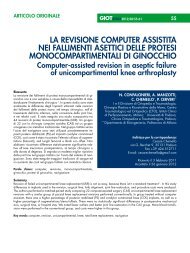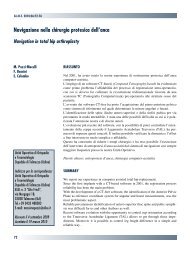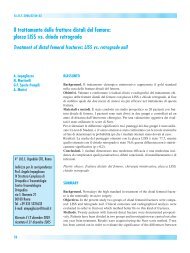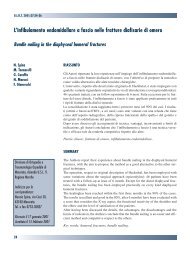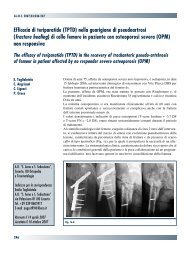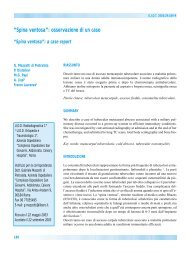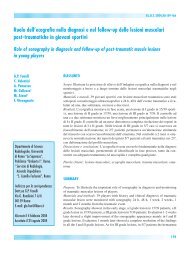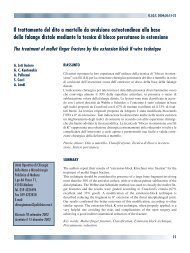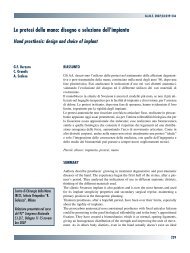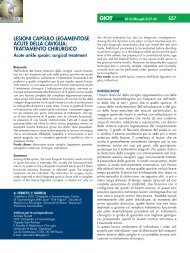- Page 1 and 2:
Organo ufficiale della Società Ita
- Page 3 and 4:
Indice INDICE MAIN SESSION I - Mala
- Page 5 and 6:
INDICE MAIN SESSION VII - Ingegneri
- Page 7:
INDICE Matematizzazione di un’ost
- Page 10 and 11:
L’endocrinologo e le malattie del
- Page 12 and 13:
L’endocrinologo e le malattie del
- Page 14 and 15:
La chirurgia nell’artropatia ocro
- Page 16 and 17:
G.I.O.T. 2010;36(suppl. 1):S8-S12 C
- Page 18 and 19:
Chirurgia delle fratture da fragili
- Page 20 and 21:
Chirurgia delle fratture da fragili
- Page 22 and 23:
Overview del radiologo interventist
- Page 24 and 25:
Durable Cure and reconstructive Suc
- Page 26 and 27:
Scelta del trattamento nelle metast
- Page 28 and 29:
G.I.O.T. 2010;36(suppl. 1):S20-S23
- Page 30 and 31:
Trattamento chirurgico delle metast
- Page 32 and 33:
G.I.O.T. 2010;36(suppl. 1):S24-S29
- Page 34 and 35:
Protocollo di trattamento delle met
- Page 36 and 37:
Protocollo di trattamento delle met
- Page 38 and 39:
G.I.O.T. 2010;36(suppl. 1):S30-S34
- Page 40 and 41:
Il trattamento chirurgico delle les
- Page 42 and 43:
Il trattamento chirurgico delle les
- Page 44 and 45:
L’apparato locomotore nelle malat
- Page 46 and 47:
G.I.O.T. 2010;36(suppl. 1):S38-S42
- Page 48 and 49:
Il trattamento chirurgico nel mielo
- Page 50 and 51:
Il trattamento chirurgico nel mielo
- Page 52 and 53:
Indicazioni chirurgiche nelle local
- Page 54 and 55:
Indicazioni chirurgiche nelle local
- Page 56 and 57:
Indicazioni chirurgiche nelle local
- Page 58 and 59:
G.I.O.T. 2010;36(suppl. 1):S50-S55
- Page 60 and 61:
Chirurgia protesica primaria e di r
- Page 62 and 63:
Chirurgia protesica primaria e di r
- Page 64 and 65:
G.I.O.T. 2010;36(suppl. 1):S56-S59
- Page 66 and 67:
Overview sulle malattie infettive d
- Page 68 and 69:
G.I.O.T. 2010;36(suppl. 1):S60-S62
- Page 70 and 71:
Bacterial biofilms: the ultimate ca
- Page 72 and 73:
Le infezioni tubercolari dell’app
- Page 74 and 75:
G.I.O.T. 2010;36(suppl. 1):S66-S69
- Page 76 and 77:
L’artrite infettiva ematogena ogg
- Page 78 and 79:
G.I.O.T. 2010;36(suppl. 1):S70-S75
- Page 80 and 81:
Le infezioni dell’arto superiore
- Page 82 and 83:
Le infezioni dell’arto superiore
- Page 84 and 85:
G.I.O.T. 2010;36(suppl. 1):S76 What
- Page 86 and 87:
Spondilodisciti non tubercolari za
- Page 88 and 89:
G.I.O.T. 2010;36(suppl. 1):S80-S82
- Page 90 and 91:
La sinovialectomia artroscopica nel
- Page 92 and 93:
La chirurgia del piede reumatoide
- Page 94 and 95:
La chirurgia del piede reumatoide I
- Page 96 and 97:
La chirurgia del piede reumatoide a
- Page 98 and 99:
La chirurgia del piede reumatoide F
- Page 100 and 101:
G.I.O.T. 2010;36(suppl. 1):S92-S96
- Page 102 and 103:
La coxopatia nella spondilite anchi
- Page 104 and 105:
La coxopatia nella spondilite anchi
- Page 106 and 107:
L’anca nell’artrite reumatoide
- Page 108 and 109:
L’anca nell’artrite reumatoide
- Page 110 and 111:
L’anca nell’artrite reumatoide
- Page 112 and 113:
La protesizzazione della caviglia n
- Page 114 and 115:
La protesizzazione della caviglia n
- Page 116 and 117:
aspetti genetici delle osteocondrod
- Page 118 and 119:
G.I.O.T. 2010;36(suppl. 1):S110-S11
- Page 120 and 121:
La chirurgia del nanismo disarmonic
- Page 122 and 123:
G.I.O.T. 2010;36(suppl. 1):S114-S12
- Page 124 and 125:
La malattia esostosante in età ped
- Page 126 and 127:
La malattia esostosante in età ped
- Page 128 and 129:
La malattia esostosante in età ped
- Page 130 and 131:
G.I.O.T. 2010;36(suppl. 1):S122-S12
- Page 132 and 133:
Trattamento chirurgico della scolio
- Page 134 and 135:
Trattamenti ortopedici nella distro
- Page 136 and 137:
Trattamenti ortopedici nella distro
- Page 138 and 139:
Trattamenti ortopedici nella distro
- Page 140 and 141:
L’imaging nelle malattie sistemic
- Page 142 and 143: L’imaging nelle malattie sistemic
- Page 144 and 145: Tecniche innovative per la fabbrica
- Page 146 and 147: Scaffolds e cartilagine essere sche
- Page 148 and 149: G.I.O.T. 2010;36(suppl. 1):S140 Chi
- Page 150 and 151: Protesi biologiche progressivamente
- Page 152 and 153: Protesi biologiche Fig. 3. Allograf
- Page 154 and 155: Protesi biologiche 22 Meyers MH, Jo
- Page 156 and 157: La riparazione delle lesioni della
- Page 158 and 159: La riparazione delle lesioni della
- Page 160 and 161: Medicina rigenerativa e uso di cell
- Page 162 and 163: G.I.O.T. 2010;36(suppl. 1):S154-S15
- Page 164 and 165: Scaffold 3D a confronto per la rige
- Page 166 and 167: G.I.O.T. 2010;36(suppl. 1):S158-S16
- Page 168 and 169: igenerazione cartilaginea Fig. 4. T
- Page 170 and 171: G.I.O.T. 2010;36(suppl. 1):S162-S16
- Page 172 and 173: uso di staminali da tessuto perifer
- Page 174 and 175: Overview Fig. 1. Microstruttura del
- Page 176 and 177: G.I.O.T. 2010;36(suppl. 1):S168-S17
- Page 178 and 179: L’impiego del tantalio nelle revi
- Page 180 and 181: L’impiego del tantalio nelle revi
- Page 182 and 183: L’impiego del tantalio nelle revi
- Page 184 and 185: Graft biomimetici-attivi nella chir
- Page 186 and 187: G.I.O.T. 2010;36(suppl. 1):S178-S18
- Page 188 and 189: L’avulsione della radice meniscal
- Page 190 and 191: G.I.O.T. 2010;36(suppl. 1):S182-S18
- Page 194 and 195: L’artrodesi strumentata della cer
- Page 196 and 197: G.I.O.T. 2010;36(suppl. 1):S188-S19
- Page 198 and 199: Il trattamento delle scoliosi in et
- Page 200 and 201: Il trattamento delle scoliosi in et
- Page 202 and 203: G.I.O.T. 2010;36(suppl. 1):S194-S19
- Page 204 and 205: Chirurgia mini-invasiva del rachide
- Page 206 and 207: Chirurgia mini-invasiva del rachide
- Page 208 and 209: Le protesi discali lombari vita sen
- Page 210 and 211: Le protesi discali lombari e di mag
- Page 212 and 213: Le protesi discali lombari Fig. 5.
- Page 214 and 215: Le protesi discali lombari bile sol
- Page 216 and 217: Le protesi discali lombari che intr
- Page 218 and 219: Le protesi discali lombari sono sta
- Page 220 and 221: Le protesi discali lombari Fig. 27.
- Page 222 and 223: Le protesi discali lombari (24,8%)
- Page 224 and 225: Le protesi discali lombari Tab. XI.
- Page 226 and 227: Le protesi discali lombari lombari,
- Page 228 and 229: Le protesi discali lombari a B C D
- Page 230 and 231: Le protesi discali lombari a B C D
- Page 232 and 233: Le protesi discali lombari 60 Wagne
- Page 234 and 235: Overview dispositivi innovativi in
- Page 236 and 237: G.I.O.T. 2010;36(suppl. 1):S228-S22
- Page 238 and 239: G.I.O.T. 2010;36(suppl. 1):S230-S23
- Page 240 and 241: Dilops: nuovo concetto di sintesi
- Page 242 and 243:
Femoroacetabular impingement OA, wh
- Page 244 and 245:
Vantaggi della modularità del coll
- Page 246 and 247:
Vantaggi della modularità del coll
- Page 248 and 249:
artroscopia d’anca • patologia
- Page 250 and 251:
artroscopia d’anca PaTOLOGIa SINO
- Page 252 and 253:
artroscopia d’anca ni cartilagine
- Page 254 and 255:
artroscopia d’anca L’artroscopi
- Page 256 and 257:
artroscopia d’anca La diagnosi cl
- Page 258 and 259:
Biomateriali e biotecnologie in chi
- Page 260 and 261:
Evoluzione, indicazioni e limiti de
- Page 262 and 263:
G.I.O.T. 2010;36(suppl. 1):S254-S25
- Page 264 and 265:
attuali materiali e tecniche di ost
- Page 266 and 267:
G.I.O.T. 2010;36(suppl. 1):S258-S26
- Page 268 and 269:
Biologia della guarigione della rip
- Page 270 and 271:
Protesi di tibiotarsica zione sferi
- Page 272 and 273:
G.I.O.T. 2010;36(suppl. 1):S264-S26
- Page 274 and 275:
Storia ed evoluzione delle protesi
- Page 276 and 277:
Storia ed evoluzione delle protesi
- Page 278 and 279:
G.I.O.T. 2010;36(suppl. 1):S270-S27
- Page 280 and 281:
Matematizzazione di un’osteotomia
- Page 282 and 283:
Mezzi di sintesi e dispositivi inno
- Page 284 and 285:
Mezzi di sintesi e dispositivi inno
- Page 286 and 287:
attuali materiali e tecniche di ost
- Page 288 and 289:
attuali materiali e tecniche di ost
- Page 290 and 291:
Innesti massivi omoplastici nella r
- Page 292 and 293:
Innesti massivi omoplastici nella r
- Page 294 and 295:
G.I.O.T. 2010;36(suppl. 1):S286-S30
- Page 296 and 297:
Novità in tema di artroscopia di p
- Page 298 and 299:
Novità in tema di artroscopia di p
- Page 300 and 301:
Novità in tema di artroscopia di p
- Page 302 and 303:
Novità in tema di artroscopia di p
- Page 304 and 305:
Novità in tema di artroscopia di p
- Page 306 and 307:
Novità in tema di artroscopia di p
- Page 308 and 309:
Novità in tema di artroscopia di p
- Page 310 and 311:
Biomateriali e biotecnologie in chi
- Page 312 and 313:
Biomateriali e biotecnologie in chi
- Page 314 and 315:
Biomateriali e biotecnologie in chi
- Page 316 and 317:
G.I.O.T. 2010;36(suppl. 1):S308-S31
- Page 318 and 319:
attuali materiali e tecniche di ost
- Page 320 and 321:
G.I.O.T. 2010;36(suppl. 1):S312-S31
- Page 322 and 323:
Interfaccia intraneurale per il con
- Page 324 and 325:
Interfaccia intraneurale per il con
- Page 326 and 327:
G.I.O.T. 2010;36(suppl. 1):S318-S32
- Page 328 and 329:
Biomateriali e biotecnologie in chi
- Page 330 and 331:
Instabilità gleno-omerale da difet
- Page 332 and 333:
Innesti ossei in ortopedia: una rev
- Page 334 and 335:
G.I.O.T. 2010;36(suppl. 1):S326-S32
- Page 336:
Indice degli autori Abati C.N., S23



